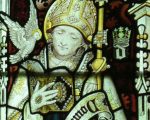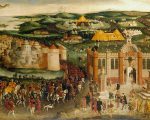
How Easter was commemorated and celebrated in Tudor times.
[Read More...]
23rd April is the feast day of St George, who we know today as the patron saint of England. It is the traditional date given for his execution in 303 AD. St George was a Roman soldier who was imprisoned, tortured and beheaded for his Christian faith after he protested against the persecution of Christians.
[Read More...]Mothering Sunday in the Tudor era.
[Read More...]
1st March is the feast day of St David (Dewi Sant), patron saint of Wales. According to Rhigyfarch’s Life of Saint David, David lived in the 6th century and founded religious centres including Glastonbury and Croyland. He then travelled to the Holy Land and was made archbishop at Jerusalem before travelling back to Wales and settling at Glyn Rhosyn (Rose Vale), or St David’s, in Pembrokeshire, Wales. There, he founded a monastery whose site is now marked by St David’s Cathedral.
[Read More...]
Lent was, and is, the lead-up to Holy Week and it lasted six and a half weeks. In Tudor times, it was a period of fasting, a time when meat, eggs, cheese and sexual relations were forbidden. Prior to this fasting was a time of celebration, Shrovetide, which began on the seventh Sunday before Easter, a day known as Shrove Sunday. The word “Shrove” came from “shriving”, the confession of sins and the receiving of absolution for them.
[Read More...]
If you haven’t taken down your Christmas decorations yet then don’t worry, you’re just following the medieval and Tudor tradition of taking them down on Candlemas Eve. 1st February was the traditional day for removing the greenery, such as laurel, holly, ivy and rosemary, which had decorated homes over the Christmas period. However, Candlemas Eve really is your last chance to rid your home of decorations and please don’t leave them up otherwise you may just get invaded by goblins!
[Read More...]
In medieval and Tudor times, the calendar year actually began on 25th March, Lady Day, but confusingly (for us anyway!) the Roman tradition of New Year was celebrated on 1st January. This was a time for the nobility and monarch to exchange gifts. The king would get dressed in his chamber and then wait for one of his consort’s servants to bring in the gift from the queen. He would then accept gifts from other courtiers and the queen would do the same in her chamber. This gift giving was an ideal opportunity for a courtier to try and win favour from the monarch or to impress the monarch with a lavish gift.
[Read More...]
In today’s Claire Chats, Claire, who is having a rather bad hair day, talks about how medieval and Tudor people kept their hair clean and what they used to colour their hair.
[Read More...]

This day in history, 7th June 1520, was the first day of the historic meeting between Henry VIII and Francis I of France. It took place between the English stronghold of Guînes and the French town of Ardres, on a piece of land referred to as the Field of Cloth of Gold.
[Read More...]
As there is currently a campaign to save one version of this painting, and there’s been a recent Claire Chats video on it, plus an 11-page report by Melanie V. Taylor, I thought it would be fun to test your knowledge of it. Good luck!
[Read More...]

Tudor Society art historian Melanie V. Taylor has written a very detailed article on the Tyrwhitt Drake Armada Portrait that has been in the news recently due to the campaign that has been launched to save it and to put it on public display at Greenwich. Please do consider helping the campaign to save this piece of history, it would be so sad if it ended up leaving the UK or being hidden in a private collection somewhere.
[Read More...]
For today’s Claire Chats I’m sharing a “Tudor Cooking with Claire” video that I have just done. In it, I make “My Lady of Middlesex’s Syllabub” recipe from the book The closet of Sir Kenelm Digby, knight, opened. It’s a really simple dessert and you can tell your guests that it’s an authentic Tudor recipe.
[Read More...]
I’ve mentioned Postscript Books before in videos, but I thought I’d write a post just highlighting them as a great resource for bargain history books. Thank you to Tudor Life contributor Olga Hughes for recommending them to me, what a find!
Postscript Books are a mailorder bookseller based in Devon, in the UK, and who offer books at up to 75% off publishers’ prices. They can offer these discounts because the books are publishers’ overstocks or remainders. By the way, I’m not affiliated to them in any way, I’m just a happy customer!
[Read More...]
Today is the 483rd anniversary of the coronation of Queen Anne Boleyn, second wife of Henry VIII. What was interesting about her coronation is that she was crowned with the crown of St Edward, a crown usually reserved for crowning the reigning monarch, so her coronation was quite a statement. Whether the use of the crown was to do with Anne’s status or to do with her unborn child, who was, of course, expected to be a prince, it is still an interesting fact.
[Read More...]